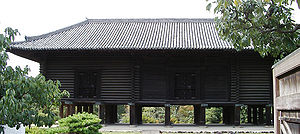Azekura-zukuri
Appearance


Azekurazukuri (校倉造, azekura-zukuri) sometimes simply called azekura, is a Japanese architectural style of simple wooden construction of certain type of buildings like storehouses (kura), granaries, and other utilitarian structures.[1] This style probably dates to the early centuries of the Common Era,[1] such as during the Yayoi or Kofun periods. It is characterized by joined-log structures of triangular cross-section, and commonly built of cypress timbers.[2]
See also
References
- ^ a b c Louis Frédéric (2002). Japan Encyclopedia. Harvard University Press. p. 63. ISBN 978-0-674-01753-5. Retrieved 24 August 2012.
- ^ http://www.britannica.com/EBchecked/topic/46760/azekura-zukuri

